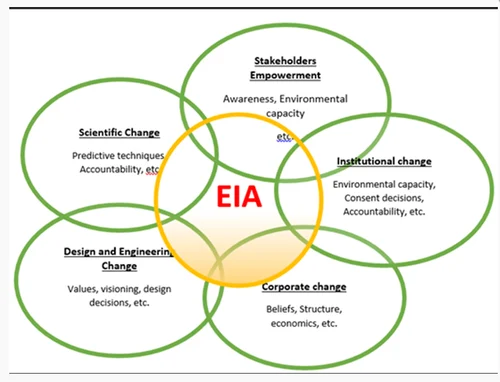Environment & Ecology, UPSC
Q.8. What role do environmental NGOs and activists play in influencing Environmental Impact Assessment (EIA) outcomes for major projects in India? cite four examples with all important details. [UPSC 2024 GS P-3]
Environmental NGOs and activists in India play a crucial role in influencing Environmental Impact Assessment (EIA) outcomes for major projects. They engage in advocacy, legal interventions, awareness campaigns, and independent assessments to ensure environmental compliance and protect ecosystems from potential harm. By raising concerns over environmental degradation, biodiversity loss, and the impact on communities, they act as watchdogs in holding corporations and government agencies accountable. Below are four examples where environmental NGOs and activists significantly influenced EIA outcomes for major projects in India:
1. Narmada Bachao Andolan (NBA) and Sardar Sarovar Dam Project
- NGO/Activist Involved: Narmada Bachao Andolan led by Medha Patkar.
- Project Details: The Sardar Sarovar Dam on the Narmada River is a large-scale hydroelectric and irrigation project in Gujarat. It has been controversial for its displacement of local populations and environmental impacts.
- Role of NGO/Activists:
- NBA challenged the EIA process, pointing out its failure to properly assess the social and environmental consequences, such as the displacement of over 200,000 people and submergence of large areas of forest land.
- The NBA’s activism led to judicial interventions, including a Supreme Court order in 2000 that halted construction until proper rehabilitation and environmental safeguards were implemented.
- The movement also forced the government to conduct additional assessments and mitigation measures, delaying the project by several years.
- Outcome: Although the dam was eventually completed, NBA’s efforts brought national and international attention to the environmental and human costs of large dam projects. This activism influenced future EIAs to give more weight to social and environmental issues.
2. POSCO Steel Plant in Odisha
- NGO/Activist Involved: Environmental groups like Greenpeace India and local activists like Dadra Tribals.
- Project Details: South Korean steel giant POSCO planned to set up a $12 billion steel plant in Jagatsinghpur, Odisha, one of the largest foreign direct investments in India. The project required clearing over 4,000 acres of forest land and threatened local ecosystems, especially mangroves.
- Role of NGO/Activists:
- Environmentalists raised concerns about the inadequate EIA process, particularly its failure to assess the ecological damage to mangroves and the displacement of tribal communities.
- Greenpeace India, in collaboration with local activists, highlighted violations of the Forest Rights Act, arguing that the project would destroy livelihoods and traditional lands.
- Legal interventions and protests led to a Ministry of Environment and Forests (MoEF) review of the EIA, leading to a temporary halt of environmental clearances.
- Outcome: Due to sustained pressure from NGOs, protests, and legal challenges, the POSCO project was delayed for years and eventually abandoned in 2017, marking a victory for environmental activists and tribal communities.
3. Vedanta Bauxite Mining in Niyamgiri Hills
- NGO/Activist Involved: Dongria Kondh tribals, supported by Survival International, and local activist groups.
- Project Details: The Vedanta Resources proposed a bauxite mining project in the Niyamgiri Hills in Odisha, intending to supply raw material to its aluminum refinery.
- Role of NGO/Activists:
- Activists and tribal communities raised concerns that the project would destroy sacred lands of the Dongria Kondh tribe and lead to severe deforestation.
- Survival International launched a global campaign, putting pressure on the Indian government to review the project’s EIA, which they argued had failed to adequately assess the impact on tribal rights and biodiversity.
- In 2010, the Ministry of Environment and Forests under Jairam Ramesh rejected Vedanta’s mining proposal, citing violations of environmental laws and tribal rights.
- Outcome: The Supreme Court of India later empowered the Dongria Kondh tribe to decide whether the project should proceed, and in 2013, tribal councils unanimously rejected the mining project. This case set a precedent for involving indigenous communities in EIA processes, emphasizing the need for a holistic approach.
4. Sterlite Copper Plant in Tuticorin, Tamil Nadu
- NGO/Activist Involved: Local environmentalists, National Alliance of People’s Movements (NAPM), and activists like Vaiko.
- Project Details: The Sterlite Copper Plant owned by Vedanta in Tuticorin was one of India’s largest copper smelters. It faced criticism for causing severe air and water pollution, which led to public health crises in the region.
- Role of NGO/Activists:
- Activists claimed that the EIA had inadequately addressed the plant’s contribution to toxic emissions and contamination of local water bodies, including the Gulf of Mannar, a biodiversity hotspot.
- Environmental groups campaigned for a thorough review of the plant’s environmental compliance and pushed for its closure. Mass protests in 2018 turned violent, leading to the death of 13 protestors.
- The Tamil Nadu Pollution Control Board (TNPCB), under pressure from activists and public outcry, ordered the plant’s closure, and subsequent investigations revealed violations in the plant’s environmental clearance conditions.
- Outcome: The Tamil Nadu government permanently shut down the plant in May 2018, citing environmental violations and health hazards. The case highlighted the power of grassroots activism in influencing EIA outcomes and corporate accountability for environmental degradation.
Conclusion
Environmental NGOs and activists have been instrumental in ensuring that EIAs are conducted thoroughly, with due consideration given to social, ecological, and community impacts. These examples underscore their role in challenging inadequate assessments, enforcing compliance, and driving the implementation of sustainable and responsible development practices in India. Their efforts not only safeguard the environment but also protect vulnerable communities from the negative impacts of industrial projects.


